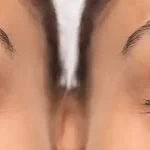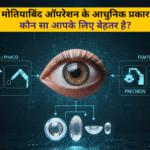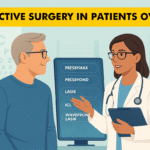The arrival of a newborn is a great occasion for the entire family to celebrate. The baby becomes the cynosure of all present. Everyone seems to ooh and aah about the baby’s eyes and cute face. For parents, it is important to look beyond the colour of their baby’s eyes and look closely to detect gross abnormalities, if any. There are signs that can be detected at home. And any eye abnormality detected at birth should be immediately brought to the notice of an eye specialist. Dr. Mahipal S. Sachdev, Chairman and Medical Director, Centre for Sight, Delhi where expert pediatric ophthalmology services are provided to screen and treat babies for various eye related disorders explains, “It takes around two years for a baby’s eyes to develop to a size similar to that of an adult. Eye infections in newborns are not uncommon. Between the period of birth and three weeks, a baby can suffer from neonatal conjunctivitis. It presents as redness and discharge. This infection needs to be controlled by using appropriate antibiotics prescribed by an eye specialist.” During the first four weeks of a baby’s life, the tear secretions are less than normal, so any watering from the eye is abnormal. Discharge and watering from the eyes at birth suggests infection, while the appearance of the same symptoms when the baby is three weeks old or more suggests the failure of the tear ducts to open. Tear ducts are tiny tubes connecting the inner ends of the eye to the nose to drain the tears into the nose. They usually develop after three to four weeks. Massage at the bridge of nose and antibiotic drops may help. If watering does not stop, a probing procedure of passing a blunt probe through the tear ducts to open them is recommended. Dr. Sachdev adds, “Believe it or not, Kala Motia (glaucoma) may be present at birth. Buphthalmos or infantile glaucoma is a condition in which watering may be accompanied by severe sensitivity to light. It can result in complete blindness as the eye tends to enlarge due to increased pressure. Therefore big eyes may not always be normal. It can be treated well with drops followed by surgery.” Sometimes infections inside the eye of a baby may have been transmitted from the mother during pregnancy. This can be confirmed by performing the TORCH test on both the mother and the child. Any obvious abnormality of the eyelid should also be taken seriously. Though it is not common, but a child may have a congenital eyelid coloboma in which a part of the eyelid may be missing. Normally, the eyelid covers 1-2mm of the cornea. But, in case it covers more than that, it is a condition called drooping of the eyelid or ‘Ptosis’. A baby’s eye movements must be observed carefully. If there is any restriction in the eye movement, it may be nerve palsy. Watch your child for evidence of poor vision or crossed eyes.
Spotting eye problems
Signs that a child may have vision problems include:
- Constant eye rubbing
- Extreme light sensitivity
- Poor focusing
- Poor visual tracking in following an object
- Abnormal alignment or movement of the eyes after the age of 6 months
- Chronic redness of the eyes
- Chronic tearing of the eyes
- A white pupil instead of black
In school-going children, watch for other signs such as:
- Inability to see objects at a distance
- Inability to read the blackboard
- Squinting
- Difficulty in reading
- Sitting too close to the TV
The importance of vision screening
There are many eye conditions and diseases that can affect a child’s vision. Some of the more common focus and alignment disorders and eye diseases are discussed below. Early diagnosis and treatment are critical to maintain the child’s eye health. And if you suspect any of the following conditions in your child, then it needs to be examined by an ophthalmologist.
Amblyopia
Dr. Sachdev says, “Amblyopia – also called lazy eye – is poor vision in an eye that may appear to be normal usually during early childhood. Two common causes are crossed eyes and a difference in the refractive error between the two eyes. If left untreated, amblyopia can cause irreversible visual loss in the affected eye. By then, signals from the misaligned eye are ‘turned off’ by the brain to avoid double vision, so the child uses only the better-seeing eye. Amblyopia is best treated during the preschool years.”
Strabismus
Strabismus is a misalignment of the eyes. The movements of the eyes may turn in, out, up, or down. It is also known as crossed eyes. If the same eye is chronically misaligned, amblyopia may also develop in that eye. Crossed eyes may occur in newborns or later in life, which can cause problems with double vision. With early detection, vision can be restored by patching the properly aligned eye, which forces the misaligned one to work. Surgery or specially designed glasses may also help the eyes to get aligned.
Refractive errors
Dr. Sachdev adds, “Refractive errors mean that the shape of the eye doesn’t refract, or bend light properly, so images appear blurred. Refractive errors can also cause amblyopia. Nearsightedness is the most common refractive error in school-age children.” Others include farsightedness and astigmatism:
- Nearsightedness is poor distance vision also called myopia. It is usually treated with glasses or contacts.
- Farsightedness is poor near vision and is also called hyperopia. It is usually treated with glasses or contacts.
- Astigmatism is the imperfect curvature of the front surface of the eye. It is usually treated with glasses if it causes blurred vision or discomfort
Ptosis
Ptosis is the drooping of the upper eyelid. The upper eyelid may droop either partially or completely leading to restriction of normal vision of the child. In the more severe cases, the eyelid may droop so much that it actually blocks the child’s vision. Ptosis can be present at birth or can be caused by an injury or disease. If a child is born with ptosis, it is called “congenital ptosis.” Congenital ptosis is caused by either poor development of the muscle responsible for raising the eyelid, nerve damage of these muscles or loose skin of the upper eyelid. This condition usually doesn’t improve on its own over time. . If it is not corrected, a condition called amblyopia (lazy eye) may develop. Amblyopia is poor vision in an eye that did not develop normal sight during early childhood. If left untreated, amblyopia can lead to poor vision permanently. This problem can be treated by a surgical procedure to lift up the drooping eyelid and should be performed at the earliest in severe cases. There are different procedures that are used to correct ptosis. The choice of treatment can be made after detailed assessment of the problem and should be performed by the hands of a trained oculoplastic surgeon. It is very important that children with ptosis have regular ophthalmic examinations early in life to protect them from the serious consequences of untreated amblyopia.
Cloudy eyes
Dr. Sachdev explains, “If the surface of the eye, which is normally clear, instead appears cloudy, the child may have a cataract or eye disorder that needs treatment. Another eye condition that requires immediate attention is retinopathy of prematurity. This is a disease that affects the eyes of premature babies. It is a leading cause of vision loss and could even result in blindness if not treated.”
According to Dr. Sachdev, eye conditions associated with a family history to look out for include:
Retinoblastoma is a malignant tumor that usually appears in the first 3 years of life. The affected eye or eyes may have visual loss and whiteness in the pupil. Congenital cataracts:Unlike most cataracts which occur with age, congenital cataracts are present at the time of birth. Symptoms of congenital cataracts include: – Gray or white cloudiness of the pupil which is black in color in normal cases – Newborn does not seem to be able to see, in case cataracts are in both eyes Family history of inheritable disorders could be a cause of congenital or infantile cataracts. Prenatal and pregnancy history can also provide clues of probability of this disease being present. To diagnose the disease, the infant should have a complete eye examination by an ophthalmologist. Prompt treatment of visually significant cataracts is necessary to allow proper development of vision. Moderate to severe cataracts that affect vision or a cataract that is only present in one eye, need to be treated with cataract surgery, An IOL (intra ocular lens) may be transplanted depending upon the age of the patient and discretion of the surgeon. Removing a congenital cataract is usually a safe procedure with good results. Post-operative supervision and follow ups for vision rehabilitation are required for optimal visual outcome. Congenital glaucomais a rare condition in infants that may be inherited. It is the result of incorrect or incomplete development of the eye drainage canals before birth and can be treated with medication and surgery. Genetic or metabolic diseases of the eye, are one of the inherited disorders that make a child more likely to develop retinoblastoma or cataracts. They may require kids to have eye exams at an early age and regular screenings. *The views expressed here are solely those of the author in his private capacity and do not in any way represent the views of Centre for Sight.





